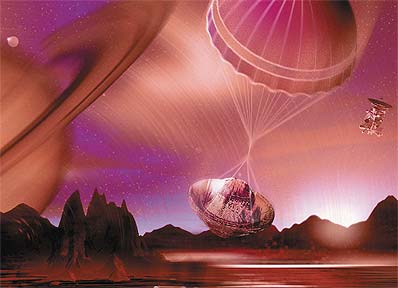
Spaceflight Now +

|

|

|

|

Premium video content for our Spaceflight Now Plus subscribers.

Genesis recovered
 Workers recover the Genesis solar wind samples from the impact crater and take the equipment into a facility for examination. (2min 08sec file) Workers recover the Genesis solar wind samples from the impact crater and take the equipment into a facility for examination. (2min 08sec file)
 Play video Play video

Post-impact news briefing
 Officials hold a post-landing news conference in Utah a couple hours after Genesis returned to Earth on Sept. 8. (40min 52sec file) Officials hold a post-landing news conference in Utah a couple hours after Genesis returned to Earth on Sept. 8. (40min 52sec file)
 Play video Play video

Capsule first spotted
 Powerful tracking cameras spot the Genesis capsule for the first time a couple hundred thousand feet above Earth, prompting applause in the control centers. But just moments later, that joy turned to heartbreak. (1min 02sec file) Powerful tracking cameras spot the Genesis capsule for the first time a couple hundred thousand feet above Earth, prompting applause in the control centers. But just moments later, that joy turned to heartbreak. (1min 02sec file)
 Play video Play video

Genesis crash lands
 The Genesis sample return capsule tumbles through the sky and impacts the desert floor in Utah after its speed-slowing chute and parafoil failed to deploy for a mid-air recovery by a helicopter. (2min 29sec file) The Genesis sample return capsule tumbles through the sky and impacts the desert floor in Utah after its speed-slowing chute and parafoil failed to deploy for a mid-air recovery by a helicopter. (2min 29sec file)
 Play video Play video

Slow-motion
 This slow-motion video shows the Genesis capsule slamming into the ground. (1min 06sec file) This slow-motion video shows the Genesis capsule slamming into the ground. (1min 06sec file)
 Play video Play video

Aerial views of crater
 Aerial views show the Genesis capsule half buried in the Utah desert floor after its landing system suffered a failure. (1min 53sec file) Aerial views show the Genesis capsule half buried in the Utah desert floor after its landing system suffered a failure. (1min 53sec file)
 Play video Play video

 Become a subscriber Become a subscriber
 More video More video

|

|

|

|

|

|

Huygens test successful
EUROPEAN SPACE AGENCY NEWS RELEASE
Posted: September 19, 2004
ESA's Huygens probe, now orbiting Saturn on board the NASA/ESA/ASI Cassini spacecraft, is in good health and successfully passed its fifteenth 'In-Flight Checkout' on 14 September 2004.

An artist's concept shows Huygens parachuting to Titan after deployment from the Cassini orbiter. Credit: EADS Astrium
|
This in-flight checkout procedure was the last but one planned before separation of the Huygens probe from Cassini in December this year, and it included some specific activities that were intended to prepare for the separation. The main difference in this procedure from previous checkouts was that there was a test of the Master Timer Unit (MTU).
Because Huygens will spend three weeks coasting towards Titan following separation from the Cassini orbiter, its systems and instruments are powered down.
The MTU is the 'triple-redundant' alarm-clock that has the most important job of waking up Huygens a few hours before its entry into Titan's atmosphere.
The checkout also included some specific payload activities required to configure the Huygens instruments before separation.
The procedure was carried out live, with Cassini transmitting the data to Earth in real-time. However the data arrived on Earth with an 80-minute delay as this is the time taken for light, and therefore radio signals, to travel the distance between Saturn and Earth.
The preliminary analysis of the real-time data received, performed within 12 hours after the test, indicates that the MTU test was successful, and that all instruments performed as expected.
|

|

|

|
|



